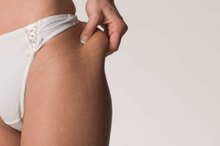Pear Shape Before and After Weight Loss
Individuals with a pear shape tend to lose weight first in the face and upper body. As you continue to lose weight, however, the weight change will show up in other places, too. Take measurements before and after weight loss to help you gauge your progress. With the right balance of diet and exercise, you can lose weight, keep it off and build definition into your upper body.
Identification
Characteristics of the pear shape include narrow shoulders and a tendency to store extra weight in the lower body. The pear shape is more common in women, but men can also carry weight in a pear-shaped pattern. Although body shape and the tendency to have overweight or obesity are very likely genetic, diet and exercise habits are the primary culprits in weight issues.
Factors
How Can I Get Curves if I'm an Apple Shape?
Learn More
Weight loss and weight maintenance strategies follow basic principles, regardless of body shape. To lose weight, you need to create a negative calorie balance. The American Heart Associations recommends that you approach weight management by first determining the amount of calories you need to support your weight goal and your level of physical activity. Set your calorie target so that you take in 250 to 500 fewer calories than you burn. Continue to maintain and improve your diet and exercise routine once you have reached your goal to prevent the regain of lost weight.
Potential
Although genes strongly influence the shape of your body, building tone in the upper body during and after weight loss helps balance your proportions. Strength-building exercises that work the arms and shoulders help broaden the upper body and build calorie-burning lean muscle mass. An intensive cardiovascular regimen also makes a difference, burning more calories to boost weight loss and keep it off.
Considerations
The Quickest Way to Get an Hourglass Shape
Learn More
A pear-shaped body may put you at lowered risk for weight-related health problems, according to the Weight-Control Information Network. Excess fat around the middle, a common characteristic of apple-shaped individuals, puts you at higher risk for heart disease and type 2 diabetes, according to the National Heart, Lung and Blood Institute. Women who carry more weight in the lower body may experience a change in weight distribution after menopause, taking on more of an apple shape.
Maintenance
Weight maintenance after your reach your goal relies on the same strategies that helped you get the weight off. Regular exercise and a healthy diet that meets your calorie needs are necessary to keep the weight off, regardless of your body shape. Rely on a diet rich in fruits, vegetables, whole grains and fat-free dairy products. Eat lean meat and poultry in moderation, and include fish in your eating plan at least twice a week. Spend 30 minutes to an hour exercising each day and continue toning exercises for the upper body.
Related Articles
References
Writer Bio
Pam Murphy is a writer specializing in fitness, childcare and business-related topics. She is a member of the National Association for Family Child Care and contributes to various websites. Murphy is a licensed childcare professional and holds a Bachelor of Arts in English from the University of West Georgia.









